Choosing the Best CMS
It’s harder than ever to choose a CMS. While proven platforms like Wordress and Drupal are still going strong, a host of new content management systems have emerged. Some promise ease-of-use, others promise drag-and-drop control, while others focus on developer friendliness.
In 2018, there is still no perfect CMS, but there is a CMS that is perfect for you.
Here’s the lineup:
Craft CMS
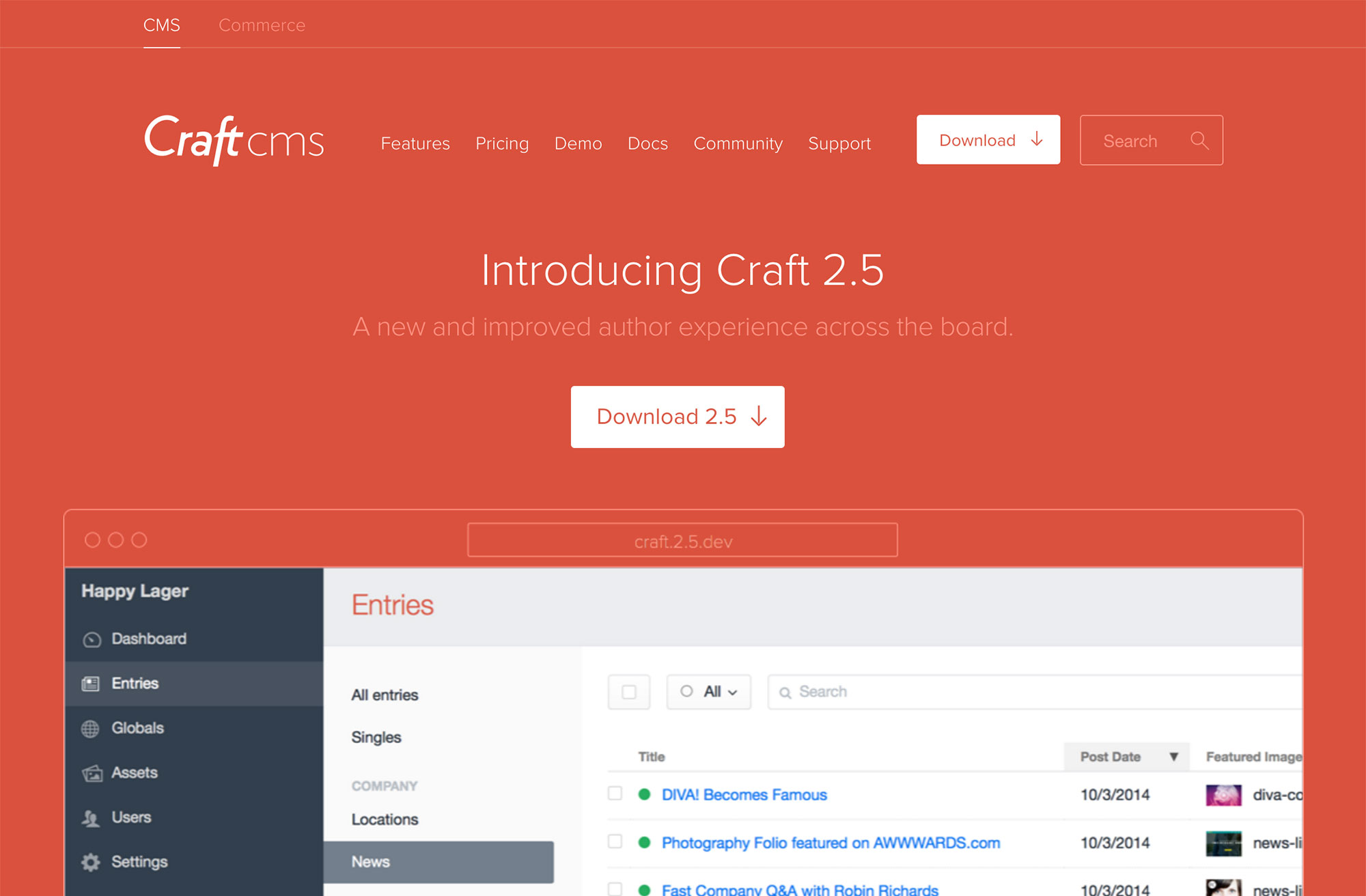
Ease of use: 4/5
Flexibility: 5/5
Documentation: 5/5
Community: 4/5
Coding skills required: Definitely!
Best for: Large, complex sites
Cost: Client sites starting at $199/install
Hosting: Self-hosted
Templating language: TWIG
Markdown support: Yes
Superpowers: Elegant data structures + flexible custom fields
They say…
Craft is a content management system (CMS) that’s laser-focused on doing one thing really, really well: managing content. And since content comes in all shapes and sizes, we’ve built Craft to be as flexible as possible, without compromising on the ease of use for content authors.
I say…
Craft CMS is incredible. It is the most powerful and flexible CMS available today. The entire CMS is built to cater to your content – no matter how varied or unusual it may be. Need a page with 7 images, two blocks of text, a Google map, and a pull quote? No problem. Choose from an assortment of custom fields to build the admin interface of your dreams.
Craft CMS has a relatively steep learning curve for new developers, but the time investment upfront pays off when your client starts entering content. You’ll need to learn Craft’s data structures, custom field system, and the TWIG templating language. In the end, however, you’ll be amazed when your client figures out the majority of the admin panel without your instruction. Craft is extremely user-friendly for clients.
One downside of Craft is that it can be difficult to sell to clients who are wary of purchasing a license ($199 and up) or are worried Craft is just another trend. I can tell you that Craft is not another trend – partly because the (very reasonable) licensing fees help ensure its continued development. The platform has amassed a large and noteworthy following in a short period of time. The community is smaller than, say, Wordpress, but it is active and growing. Craft CMS is only getting better with every release and certainly has a promising future.
Use it if…
- Your content is varied and unpredictable.
- You like having absolute control over how your content is managed, organized, and entered.
- You like the idea of a CMS built around your content versus having to build your content around a CMS.
Squarespace

Ease of use: 5/5
Flexibility: 5/5
Documentation: 5/5
Community: 3/5
Coding skills required: No
Best for: Small - medium sites, sites with lots of images
Cost: Starting at $8/mo
Hosting: Hosted
Templating language: Drag-and-drop
Markdown support: No
Superpowers: Drag-and-drop design editor
They say…
Whether you need simple pages, striking galleries, a professional blog, or an online store, it’s all included with your Squarespace website. Best of all, everything is mobile-ready right from the start.
I say…
I’m a huge fan of Squarespace. I recommend it to everyone because, quite frankly, it works. There are so many cases where something like Craft CMS or Wordpress would be overkill. Say you run a coffee shop and need a simple site that includes pictures of your space, hours, and a map. You can do that with Squaresapce in two hours – without a developer or designer – and it will turn out incredibly well. Every theme is gorgeous and mobile-ready, but you can also customize the layout until you have the site of your dreams. All without touching any code. Pretty cool.
Would I use Squarespace for a custom designed client site? Usually not. Is it an effective platform for individuals and small businesses? Yes.
Use it if…
- You want a gorgeous mobile-ready site.
- You never want to touch code.
- Your site has lots of images.
- You want to customize your theme without the help of a developer.
- You don’t want to deal with hosting or technical issues.
- You want access to a dedicated support team via chat or email.
Wordpress
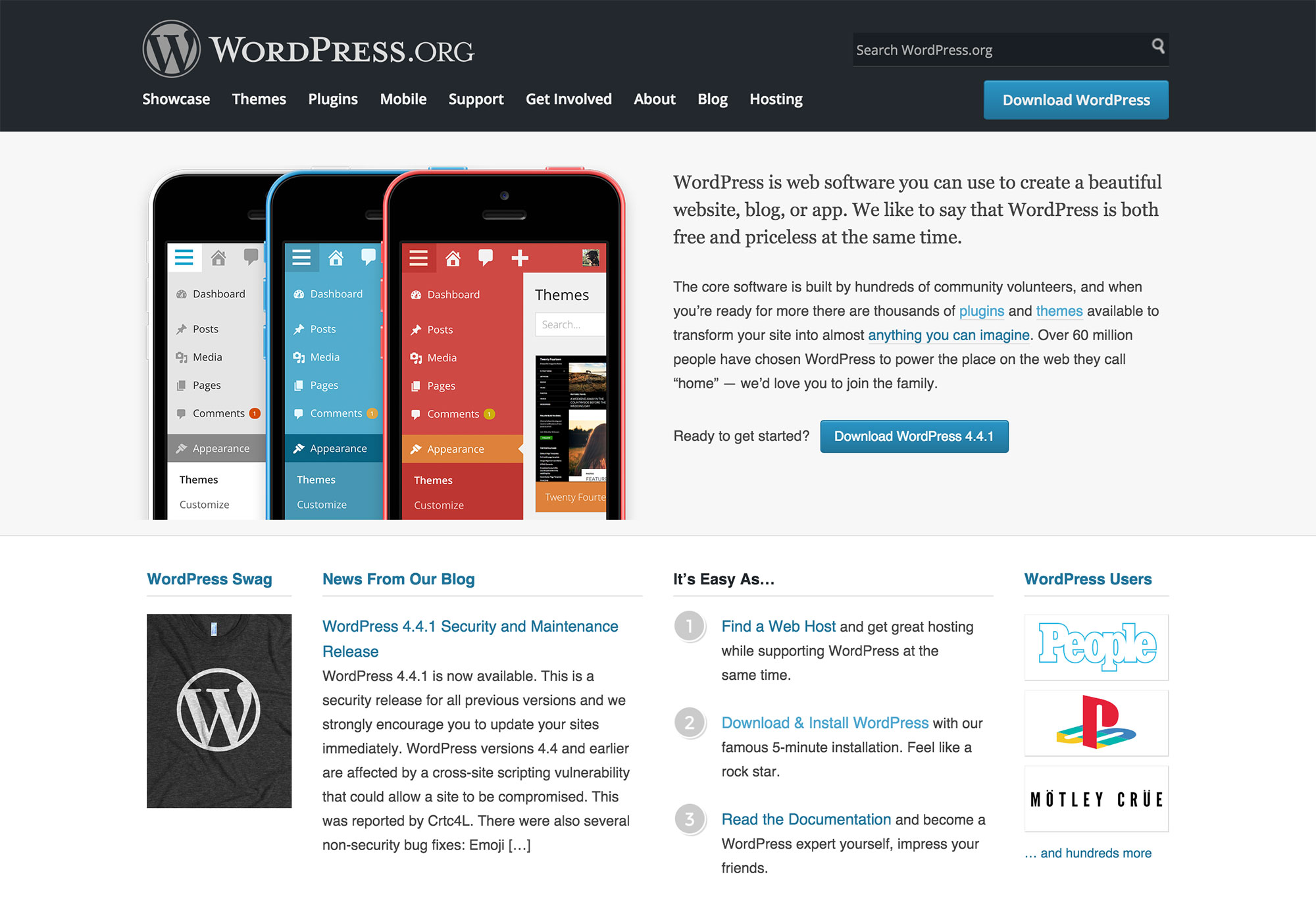
Ease of use: 3/5
Flexibility: 3/5
Documentation: 5/5
Community: 5/5
Coding skills required: No
Best for: Small - medium sites, blogs
Cost: Free
Hosting: Self-hosted (or hosted on Wordpress.com)
Templating language: PHP
Markdown support: No
Superpowers: Reliability, blogging
They say…
WordPress is web software you can use to create a beautiful website, blog, or app. We like to say that WordPress is both free and priceless at the same time.
I say…
Wordpress powers close to 20% of the web for good reason. It is a proven, mature, and dependable CMS that always gets the job done. It has the unfortunate honor of being known as a “blogging platform that can also build websites”. That’s not true. Wordpress is very much a full-blown CMS – after you install twelve plugins that completely change the core functionality.
In a lot of ways, Wordpress is hindered by its own success. It has to cater to such a wide audience and number of use cases that it can feel bloated and over-engineered at times. That said, Wordpress is still the best open-source blogging platform. It’s also a great choice if your site follows a standard website format (home page + a few basic text pages + blog). For anything else, I’d begin to question Wordpress’s viability as a CMS.
If you’re just getting started, Wordpress is an excellent choice. With over 40k plugins and 2k free themes, Wordpress makes it quick and easy to setup a site with the aesthetics and functionality you need. Many hosts also offer a 1-click install, completely removing the need to edit code yourself.
Use it if…
- You’re starting a blog.
- You want to put up a quick site with a home page + a few basic text pages + blog.
- You like having access to a huge library of free and paid themes.
- You want to support a great open-source project.
- You want a CMS with a thriving community and easily accessible documentation.
- Many people will be contributing to your site. Wordpress is great for setting permission levels (subscriber, author, editor, admin, etc).
Siteleaf
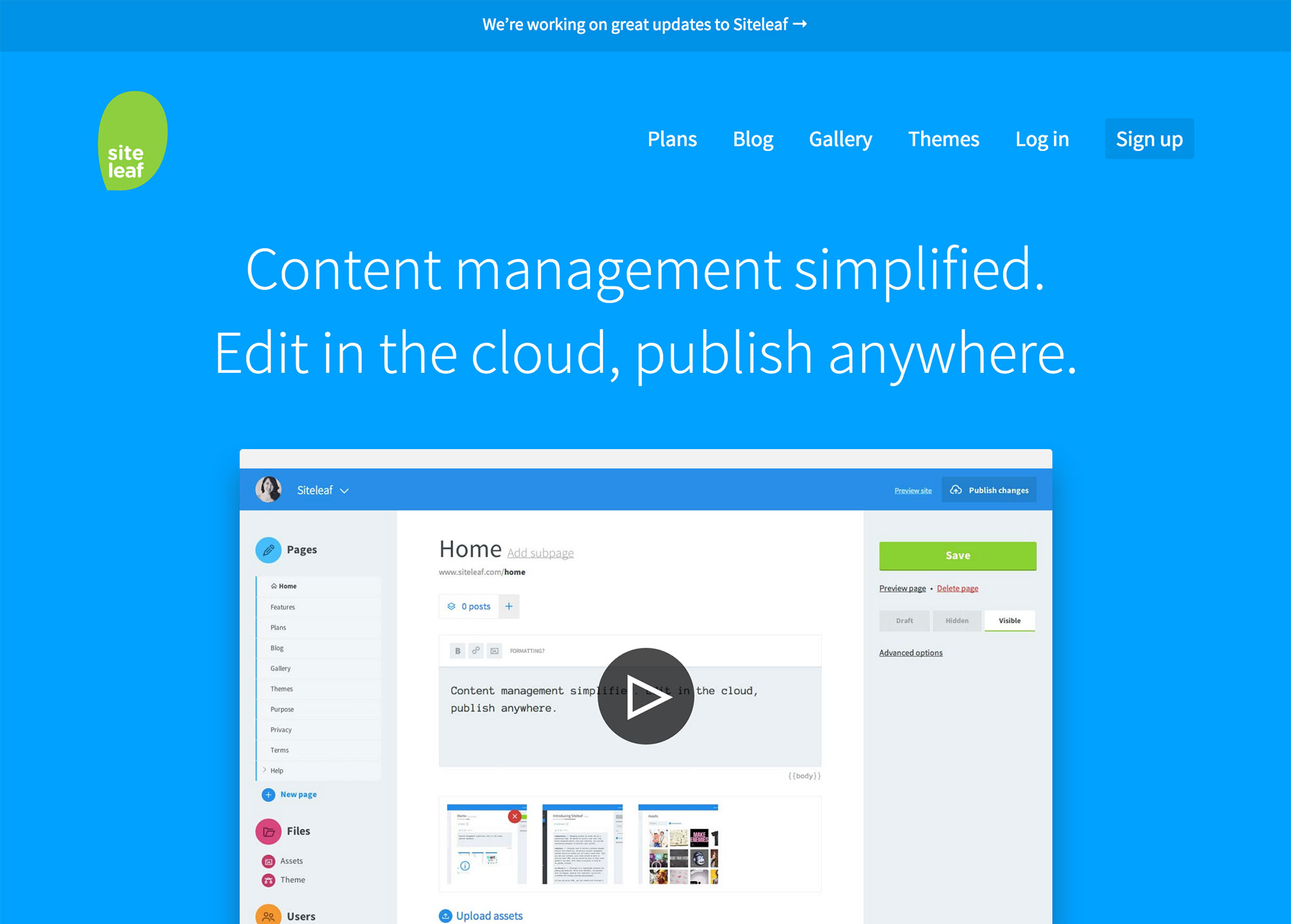
Ease of use: 5/5
Flexibility: 4/5
Documentation: 5/5
Community: 3/5
Coding skills required: Most likely
Best for: Small - medium sites, portfolios
Cost: Starting at $9/mo
Hosting: Included
Templating language: Liquid
Markdown support: Yes
Superpowers: Simple, lightweight, smart
They say…
Siteleaf is a smart, lightweight platform for creating and maintaining websites. We believe that content management shouldn’t be hard. That you should be able to host your website anywhere you want. That websites should be able to outlive their CMS. That our tools should be simplified, not dumbed down.
I say..
Siteleaf is a surprisingly powerful CMS considering its lightweight UI and ease-of-use. It seems to be the choice for agencies and artists looking to build portfolio sites (here, here, here, and here), but it’s a flexible CMS that can work for any type of content. For example, this location-based neighborhood guide is super cool and you’d never guess that Siteleaf is running under the hood.
There currently are not many themes available, which means you’ll likely need to get your hands dirty and build your own theme using the Liquid Templating Language. You’ll probably need to have some programming experience to get the results you want. That said, once you’ve built a theme, the admin interface is a joy to use and requires no coding skills.
Note for the nerds: Siteleaf v2 is going to include support for Jekyll – giving you both the power of open source and Siteleaf’s web-based editor.
Use it if…
- You’re an artist, designer, or agency in need of a custom portfolio site.
- You like simple, no-nonsense user interfaces.
- You don’t want to deal with setting up your own hosting.
- You like one of the out-of-the-box themes or are comfortable doing your own theme development / hiring a developer.
Kirby
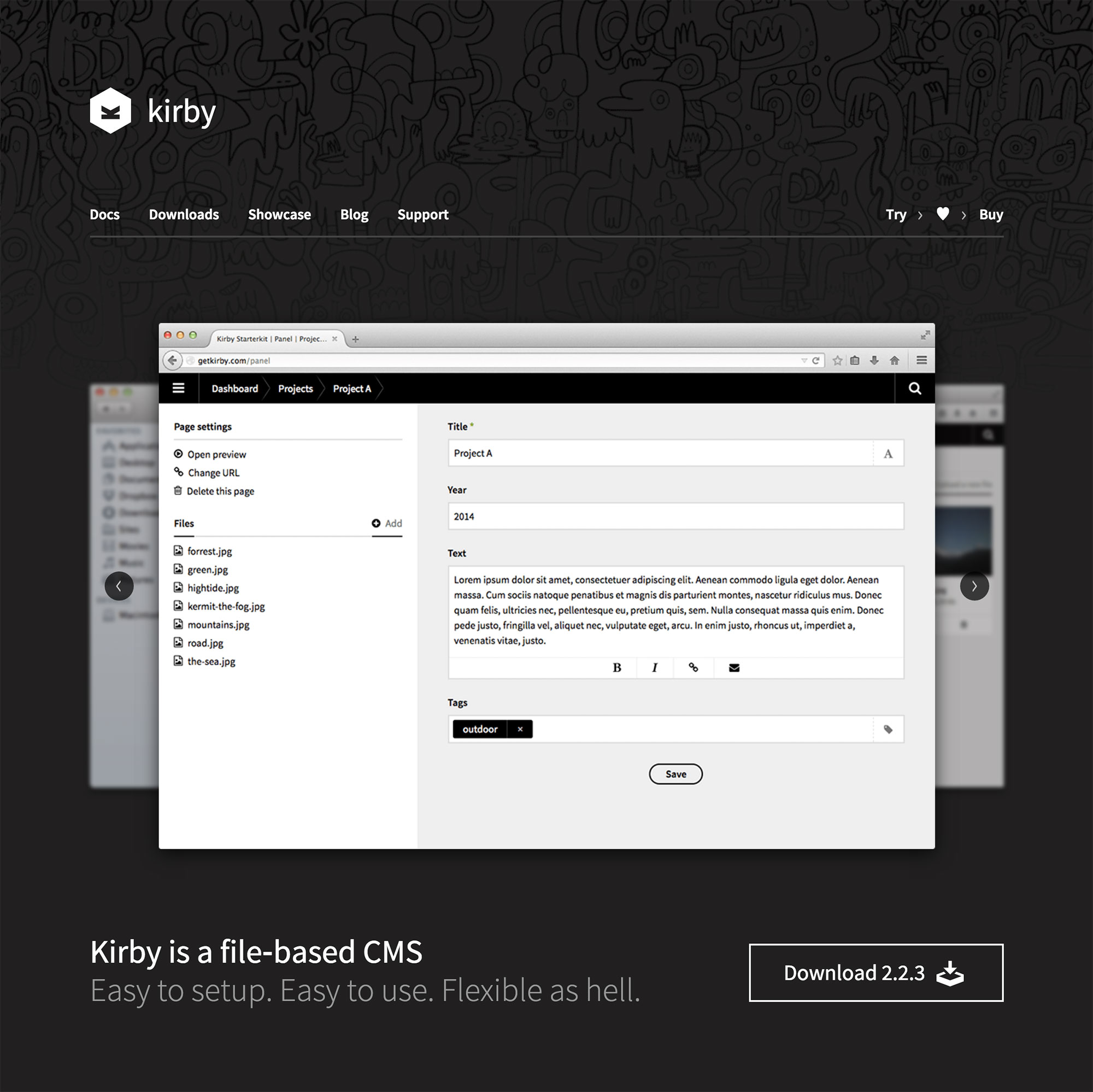
Ease of use: 4/5
Flexibility: 4/5
Documentation: 5/5
Community: 3/5
Coding skills required: No
Best for: Small - medium sites, portfolios
Cost: $17/install
Hosting: Self-hosted
Templating language: PHP
Markdown support: Yes
Superpowers: File-based, no database
They say…
Kirby is a file‑based CMS. Easy to setup. Easy to use. Flexible as hell.
I say….
Kirby is perhaps the most unique CMS on this list. Unlike the others, Kirby does not rely on a database. Content is represented by folders. A blog, for example, is simply a folder with a bunch of text files inside. This approach makes content management seem second-nature to anyone who is familiar with how a file system works.
Kirby is very popular amongst artists, photographers, and designers. The file-based structure is well-suited for creating visual case studies and portfolios. Have a bunch of images you want to show on a new page? Just make a new folder called “NYC Photo Shoot”, drag a few images in, and you’re done!
While Kirby normally requires the use of an FTP program to upload new content, it also includes a web-based admin tool that will allow you to add content more easily. There is a nice assortment of themes available for those who don’t want to program a custom solution.
Use it if…
- You want to get up and running in seconds with an instant install.
- You have a lot of visual content.
- You don’t want to mess with a database.
- You’re organized and understand how a file system works.
- You like the simplicity of a site based on a bunch of folders and text documents.
Jekyll

Ease of use: 2/5
Flexibility: 3/5
Documentation: 4/5
Community: 4/5
Coding skills required: Definitely!
Best for: Small sites, blogs, code documentation
Cost: Free
Hosting: Self-hosted or GitHub pages
Templating language: Liquid
Markdown support: Yes
Superpowers: Static output = speed + security, CLI commands
They say…
Jekyll is a simple, blog-aware, static site generator. It takes a template directory containing raw text files in various formats, runs it through a converter (like Markdown) and our Liquid renderer, and spits out a complete, ready-to-publish static website suitable for serving with your favorite web server. Jekyll also happens to be the engine behind GitHub Pages, which means you can use Jekyll to host your project’s page, blog, or website from GitHub’s servers for free.
I say…
You could argue that Jekyll is a static site generator, not a true CMS. I think it’s close enough. Jekyll is the choice of programmers and requires a large amount of technical experience to use. Jekyll is great because you can check your entire site (templates, content, assets) into a version control system like GitHub. You can even choose to have GitHub Pages host your site, making hosting free, fast, and accessible with a single commit.
Jekyll isn’t the best choice for a client-facing project unless your client also happens to have development skills. But if you’re building a personal site or you’re collaborating with a team of developers, Jekyll just might be the perfect match.
My site is powered by Jekyll and I love it! My workflow has been streamlined and can be controlled via the command line. My site also loads almost 3x faster than when I was using Wordpress.
Use it if…
- You’re extremely comfortable with code.
- You’re familiar with the command line.
- Your content is mostly static.
- Your site is fairly straightforward (pages + blog).
- You don’t need an admin interface.
- Your client doesn’t need editing access (or is highly technical).
- You like writing in markdown.
- You want your site to load fast.
- You don’t want to mess with a database.
Middleman
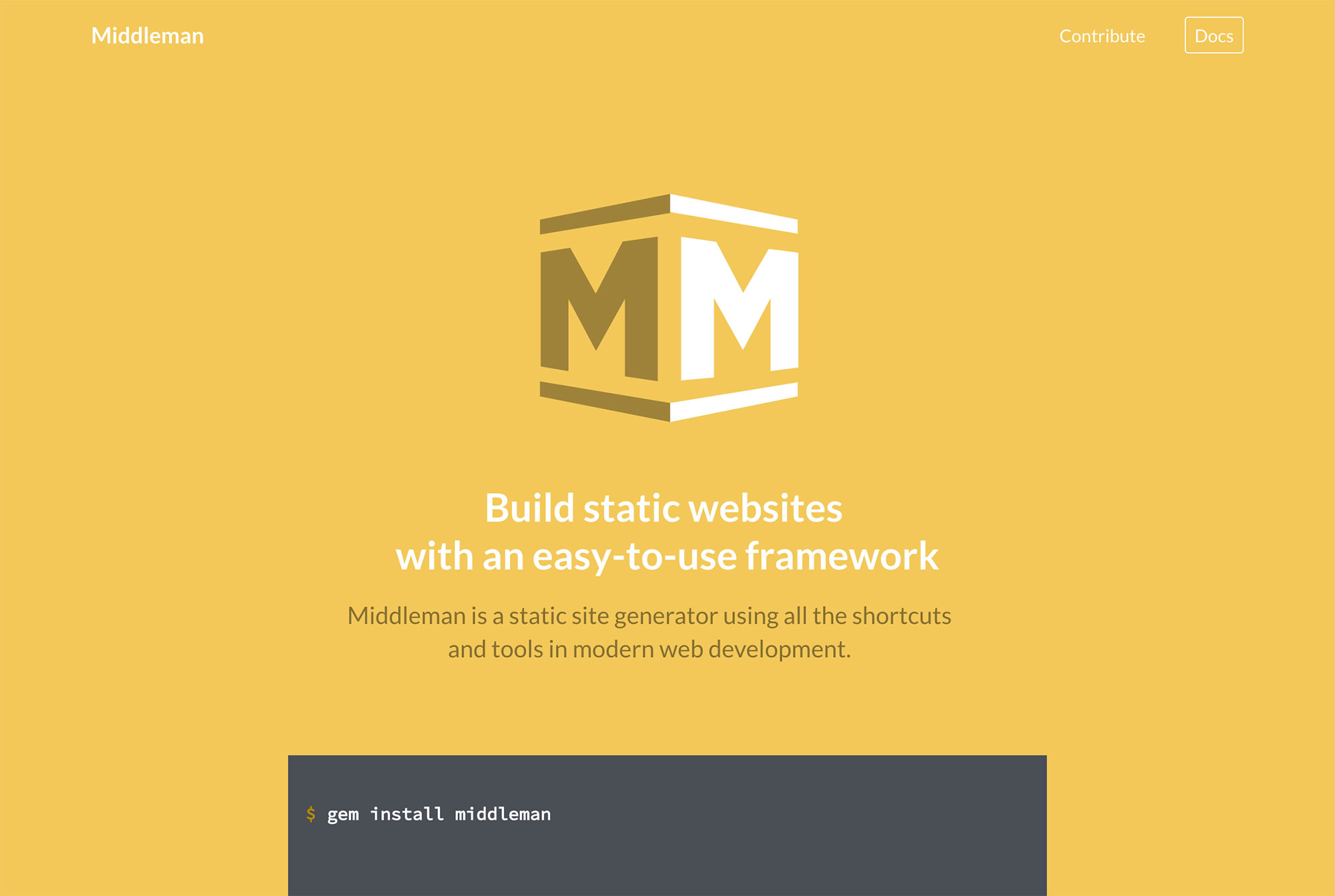
Ease of use: 2/5
Flexibility: 3/5
Documentation: 4/5
Community: 3/5
Coding skills required: Definitely!
Best for: Small sites, blogs, code documentation
Cost: Free
Hosting: Self-hosted
Templating language: ERb (embedded ruby)
Markdown support: Yes
Superpowers: Static output = speed + security, CLI commands
They say…
Middleman is a static site generator using all the shortcuts and tools in modern web development.
I say…
Middleman very closely resembles Jekyll, with some key differences. Middleman is much more open-ended and flexible than Jekyll. It allows for more deviation from the standard blog + pages format. With enough creativity and willpower, you can enlist Middleman to generate static content in almost any format – be it a blog, a marketing site, documentation or anything, really.
On the crazier end of the spectrum, Mailchimp’s entire marketing site is powered by Middleman. On the more expected end of the spectrum, SASS’s documentation site is powered by Middleman.
Use it if…
- You’re extremely comfortable with code.
- You’re familiar with the command line.
- Your content is mostly static.
- Your site structure is more complex than a few pages + blog.
- You don’t need an admin interface.
- Your client doesn’t need editing access (or is highly technical).
- You like writing in markdown.
- You want your site to load fast.
- You don’t want to mess with a database.
Drupal
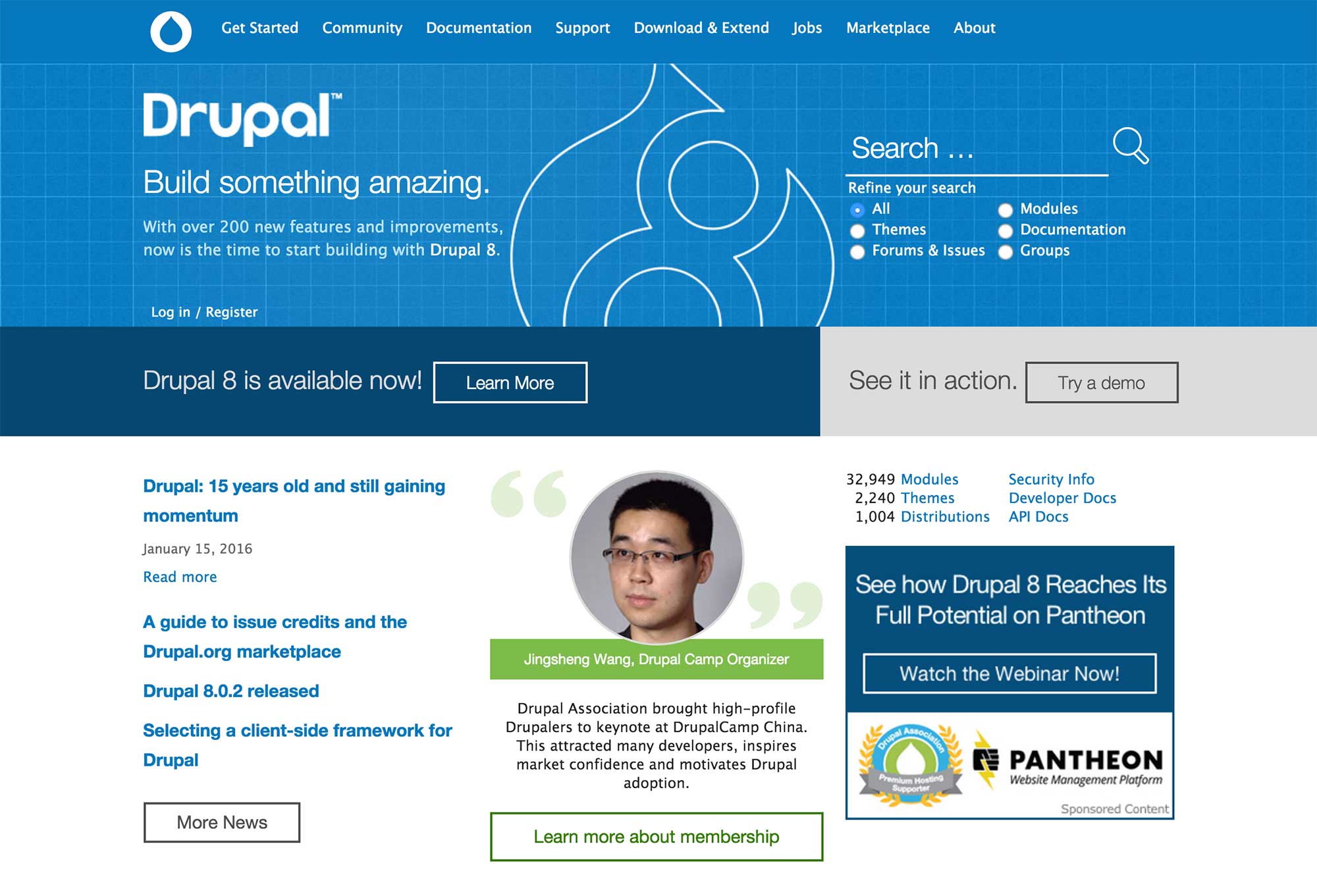
Ease of use: 2/5
Flexibility: 5/5
Documentation: 3/5
Community: 5/5
Coding skills required: Definitely!
Best for: Large, complex sites
Cost: FreeHosting: Self-hosted
Templating language: PHP
Markdown support: No
Superpowers: Reliability, extensibility, security
They say…
Drupal is content management software. It’s used to make many of the websites and applications you use every day. Drupal has great standard features, like easy content authoring, reliable performance, and excellent security. But what sets it apart is its flexibility; modularity is one of its core principles. Its tools help you build the versatile, structured content that dynamic web experiences need.
I say…
Drupal seems to be the primary choice for large institutions such as universities, corporations, and government agencies. Drupal is geared toward custom development. You’re won’t find many out-of-the-box Drupal themes because the CMS doesn’t always follow the standard headline + body copy + featured image structure. Drupal is not a one-size-fits-all solution and assumes your needs are too specific to be pigeonholed into a predefined content model.
Drupal is not a good choice for those just getting started because it requires a great deal of customization to achieve things Wordpress can do out of the box. However, if you’re a large organization with a dedicated development team in need of a custom-tailored solution, Drupal is a solid option.
Use it if…
- You’re an experienced developer or are willing to hire a developer.
- You need something more custom than a generic theme.
- You need enterprise-level security and scale.
- You want a platform that gives you the flexibility to build a truly custom site – on the front and back-end.